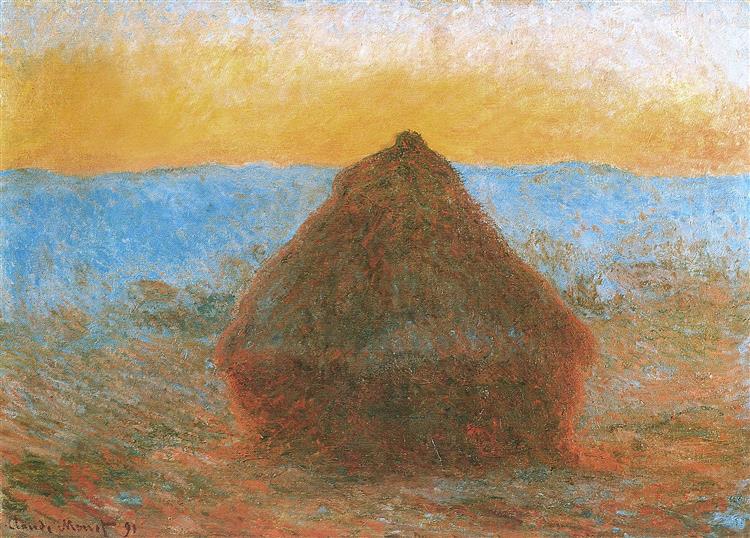Beschreibung
Claude Monet's Grainstack (1891), emblematic of the Impressionist movement, is a remarkable example of the artist's exploration of colour, light and form. In this canvas, Monet depicts one of his recurring themes: the harvest and rural life, but specifically through the unique interpretation of a large stack of hay, a motif that by the end of the 19th century had become synonymous with his rural surroundings in Giverny.
Visually, the work is structured in a way that condenses a strong visual force in the pile of grain, which occupies the centre of the painting. This element, although apparently simple, is treated with a complexity that reveals Monet's mastery. The pile has a clearly defined shape that blends harmoniously with the landscape that surrounds it. The atmosphere that envelops the composition is characterised by an almost ethereal softness, inviting the viewer to contemplate not only the shape of the object, but also its relationship with the surroundings illuminated by a soft golden glow, perhaps reflecting the light of the sunset.
The colour palette used in “Pile of Grain” is central to its visual impact. Monet uses a series of earthy tones ranging from yellows, browns and ochres, accented by hints of blue and green that outline the surrounding landscape. This colour choice not only lends a sense of warmth, but also evokes the richness of nature in full harvest. The colours are applied with loose, deliberately visible brushstrokes, typical of Impressionism, suggesting a sense of immediacy and freshness in capturing the moment.
The atmosphere of this painting is one of both serenity and contemplation, as no human figures are depicted, highlighting man’s connection to the land through agricultural work. This suggests the influence of rural life and its intrinsic relationship to the natural cycle. In this sense, the work could be seen as a tribute to country life, a celebration of work that is not directly imparted, but subtly hinted at through the depicted environment.
It is interesting to note that this work is part of a series where Monet explored the same subject in various lighting conditions and times of day, denoting his obsession with depicting the same subject from different perspectives and times. This reflection on light and its impact on colour and form can be seen in other contemporary works by the artist, such as his famous Water Lilies series or the variations of The Houses of Parliament in London.
In conclusion, “Pile of Grain” is more than just a depiction of an element of the rural landscape; it is a meditation on light, color and time, encapsulating the very essence of Impressionism and Monet’s vision. Monet’s approach to landscape reveals not only his technical skill, but also his deep emotional connection to the natural world, inviting the viewer to pause and appreciate the simplicity and beauty of everyday life.
KUADROS ©, a famous painting on your wall.
Hand-made oil painting reproductions, with the quality of professional artists and the distinctive seal of KUADROS ©.
Painting reproduction service with satisfaction guarantee. If you are not completely satisfied with the replica of your painting, we will refund 100% of your money.

